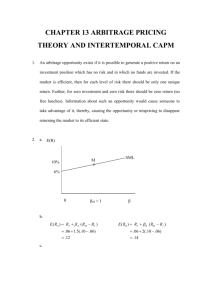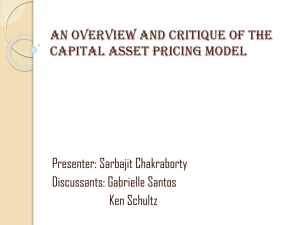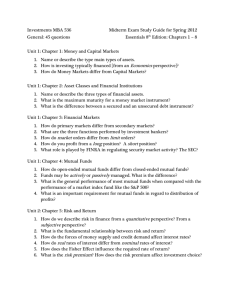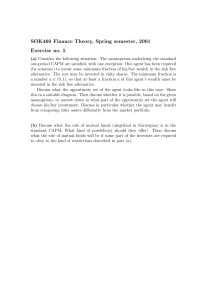15.401 Finance Theory Andrew W. Lo Lectures 15
advertisement
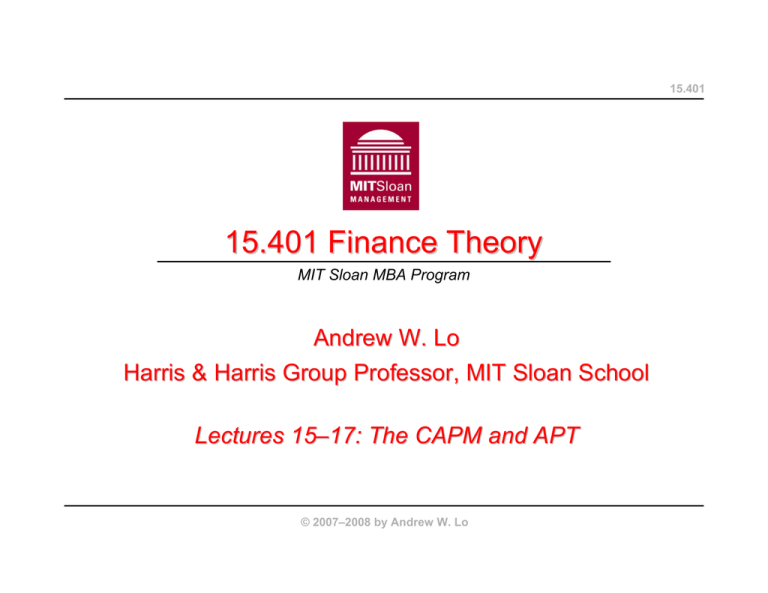
15.401 15.401 Finance Theory MIT Sloan MBA Program Andrew W. Lo Harris & Harris Group Professor, MIT Sloan School Lectures 15–17: The CAPM and APT © 2007–2008 by Andrew W. Lo Critical Concepts 15.401 Review of Portfolio Theory The Capital Asset Pricing Model The Arbitrage Pricing Theory Implementing the CAPM Does It Work? Recent Research Key Points Reading Brealey and Myers, Chapter 8.2 – 8.3 Lectures 15–17: The CAPM and APT © 2007–2008 by Andrew W. Lo Slide 2 Review of Portfolio Theory 15.401 Risk/Return Trade-Off Portfolio risk depends primarily on covariances – Not stocks’ individual volatilities Diversification reduces risk – But risk common to all firms cannot be diversified away Hold the tangency portfolio M – The tangency portfolio has the highest expected return for a given level of risk (i.e., the highest Sharpe ratio) Suppose all investors hold the same portfolio M; what must M be? – M is the market portfolio Proxies for the market portfolio: S&P 500, Russell 2000, MSCI, etc. – Value-weighted portfolio of broad cross-section of stocks Lectures 15–17: The CAPM and APT © 2007–2008 by Andrew W. Lo Slide 3 Review of Portfolio Theory 15.401 2.4% Expected Return 1.8% Motorola Tangency portfolio M IBM 1.2% GM 0.6% T-Bill 0.0% 0.0% 2.0% 4.0% Lectures 15–17: The CAPM and APT 6.0% 8.0% 10.0% 12.0% Standard Deviation of Return © 2007–2008 by Andrew W. Lo 14.0% 16.0% Slide 4 The Capital Asset Pricing Model 15.401 Implications of M as the Market Portfolio Efficient portfolios are combinations of the market portfolio and T-Bills Expected returns of efficient portfolios satisfy: This yields the required rate of return or cost of capital for efficient portfolios! Trade-off between risk and expected return Multiplier is the ratio of portfolio risk to market risk What about other (non-efficient) portfolios? Lectures 15–17: The CAPM and APT © 2007–2008 by Andrew W. Lo Slide 5 The Capital Asset Pricing Model 15.401 Implications of M as the Market Portfolio For any asset, define its market beta as: Then the Sharpe-Lintner CAPM implies that: Risk/reward relation is linear! Beta is the correct measure of risk, not sigma (except for efficient portfolios); measures sensitivity of stock to market movements Lectures 15–17: The CAPM and APT © 2007–2008 by Andrew W. Lo Slide 6 The Capital Asset Pricing Model 15.401 The Security Market Line Implications: Lectures 15–17: The CAPM and APT © 2007–2008 by Andrew W. Lo Slide 7 The Capital Asset Pricing Model 15.401 What About Arbitrary Portfolios of Stocks? Therefore, for any arbitrary portfolio of stocks: Lectures 15–17: The CAPM and APT © 2007–2008 by Andrew W. Lo Slide 8 The Capital Asset Pricing Model 15.401 We Now Have An Expression for the: Required rate of return Opportunity cost of capital Risk-adjusted discount rate Risk adjustment involves the product of beta and market risk premium Where does E[Rm] and Rf come from? Lectures 15–17: The CAPM and APT © 2007–2008 by Andrew W. Lo Slide 9 The Capital Asset Pricing Model 15.401 Example: Using monthly returns from 1990 – 2001, you estimate that Microsoft’s beta is 1.49 (std err = 0.18) and Gillette’s beta is 0.81 (std err = 0.14). If these estimates are a reliable guide going forward, what expected rate of return should you require for holding each stock? Lectures 15–17: The CAPM and APT © 2007–2008 by Andrew W. Lo Slide 10 The Capital Asset Pricing Model 15.401 Security Market Line 25% Expected Return 20% 15% β = 1, Market Portfolio 10% 5% 0% 0 0.2 0.4 Lectures 15–17: The CAPM and APT 0.6 0.8 1 Beta 1.2 1.4 © 2007–2008 by Andrew W. Lo 1.6 1.8 2 Slide 11 The Capital Asset Pricing Model 15.401 The Security Market Line Can Be Used To Measure Performance: Suppose three mutual funds have the same average return of 15% Suppose all three funds have the same volatility of 20% Are all three managers equally talented? Are all three funds equally attractive? 25% Expected Return 20% A B 15% C β = 1, Market Portfolio 10% 5% 0% 0 0.2 Lectures 15–17: The CAPM and APT 0.4 0.6 0.8 1 Beta 1.2 1.4 © 2007–2008 by Andrew W. Lo 1.6 1.8 2 Slide 12 The Capital Asset Pricing Model 15.401 Example: Hedge fund XYZ had an average annualized return of 12.54% and a return standard deviation of 5.50% from January 1985 to December 2002, and its estimated beta during this period was −0.028. Did the manager exhibit positive performance ability according to the CAPM? If so, what was the manager’s alpha? Lectures 15–17: The CAPM and APT © 2007–2008 by Andrew W. Lo Slide 13 The Capital Asset Pricing Model Example (cont): 15.401 Cumulative Return of XYZ and S&P 500 January 1985 to December 2002 16 14 Cumulative Return 12 10 8 6 4 2 n02 Ja n01 Ja n00 Ja n99 Ja Ja n98 n97 Ja n96 Ja n95 Ja n94 Ja n93 Ja n92 Ja n91 Ja n90 Ja n89 Ja n88 Ja n87 Ja n86 Ja Ja n85 0 Month XYZ Lectures 15–17: The CAPM and APT S&P 500 © 2007–2008 by Andrew W. Lo Slide 14 The Arbitrage Pricing Theory 15.401 What If There Are Multiple Sources of Systematic Risk? Let returns following a multi-factor linear model: Then the APT implies the following relation: Cost of capital depends on K sources of systematic risk Lectures 15–17: The CAPM and APT © 2007–2008 by Andrew W. Lo Slide 15 The Arbitrage Pricing Theory 15.401 Strengths of the APT Derivation does not require market equilibrium (only no-arbitrage) Allows for multiple sources of systematic risk, which makes sense Weaknesses of the APT No theory for what the factors should be Assumption of linearity is quite restrictive Lectures 15–17: The CAPM and APT © 2007–2008 by Andrew W. Lo Slide 16 Implementing the CAPM 15.401 Parameter Estimation: Security market line must be estimated One unknown parameter: β Given return history, β can be estimated by linear regression: Lectures 15–17: The CAPM and APT © 2007–2008 by Andrew W. Lo Slide 17 Implementing the CAPM Lectures 15–17: The CAPM and APT © 2007–2008 by Andrew W. Lo 15.401 Slide 18 Does It Work? 15.401 Biogen vs. VWRETD 40% 30% y = 1.4242x - 0.0016 R 2 = 0.3336 20% 10% 0% -20.0% -15.0% -10.0% -5.0% 0.0% 5.0% 10.0% 15.0% -10% -20% -30% -40% Lectures 15–17: The CAPM and APT © 2007–2008 by Andrew W. Lo Slide 19 Does It Work? 15.401 NASDAQ vs. VWRETD 20% 15% 10% 5% 0% -20% -15% -10% -5% 0% 5% 10% 15% 20% -5% -10% -15% -20% Lectures 15–17: The CAPM and APT © 2007–2008 by Andrew W. Lo Slide 20 Does It Work? 15.401 Market-Cap Portfolios: Over the past 40 years, the smallest firms (1st decile) had an average monthly return of 1.33% and a beta of 1.40. The largest firms (10th decile) had an average return of 0.90% and a beta of 0.94. During the same time period, the Tbill rate averaged 0.47% and the market risk premium was 0.49%. Are the returns consistent with the CAPM? Lectures 15–17: The CAPM and APT © 2007–2008 by Andrew W. Lo Slide 21 Does It Work? 15.401 Size-Sorted Portfolios, 1960 – 2001 1.40 Average Monthly Returns 1.30 1.20 1.10 1.00 0.90 0.80 0.70 0.60 0.70 0.90 1.10 1.30 1.50 1.70 Beta Lectures 15–17: The CAPM and APT © 2007–2008 by Andrew W. Lo Slide 22 Does It Work? 15.401 Beta-Sorted Portfolios, 1960 – 2001 18% Average Annual Returns 16% 14% 12% 10% 8% 6% 4% 0.50 0.70 0.90 1.10 1.30 1.50 1.70 Beta Lectures 15–17: The CAPM and APT © 2007–2008 by Andrew W. Lo Slide 23 Does It Work? 15.401 Beta-Sorted Portfolios, 1926 – 2004 16.0 14.0 12.0 10.0 8.0 6.0 4.0 Low 2 3 4 5 6 7 8 9 High Firms sorted by ESTIM ATED BETA Lectures 15–17: The CAPM and APT © 2007–2008 by Andrew W. Lo Slide 24 Does It Work? 15.401 Volatility-Sorted Portfolios, 1926 – 2004 16.0 14.0 12.0 10.0 8.0 6.0 4.0 Low 2 3 4 5 6 7 8 9 High Firms sorted by ESTIMATED VOLATILITY Lectures 15–17: The CAPM and APT © 2007–2008 by Andrew W. Lo Slide 25 Recent Research 15.401 Other Factors Seem To Matter Book/Market (Fama and French, 1992) Liquidity (Chordia, Roll, and Subrahmanyam, 2000) Trading Volume (Lo and Wang, 2006) But CAPM Still Provides Useful Framework For Applications Graham and Harvey (2000): 74% of firms use the CAPM to estimate the cost of capital Asset management industry uses CAPM for performance attribution Pension plan sponsors use CAPM for risk-budgeting and asset allocation Lectures 15–17: The CAPM and APT © 2007–2008 by Andrew W. Lo Slide 26 Key Points 15.401 Tangency portfolio is the market portfolio This yields the capital market line (efficient portfolios) The CAPM generalizes this relationship for any security or portfolio: The security market line yields a measure of risk: beta This provides a method for estimating a firm’s cost of capital The CAPM also provides a method for evaluating portfolio managers – Alpha is the correct measure of performance, not total return – Alpha takes into account the differences in risk among managers Empirical research is mixed, but the framework is very useful Lectures 15–17: The CAPM and APT © 2007–2008 by Andrew W. Lo Slide 27 Additional References 15.401 Bernstein, 1992, Capital Ideas. New York: Free Press. Bodie, Z., Kane, A. and A. Marcus, 2005, Investments, 6th edition. New York: McGraw-Hill. Brennan, T., Lo, A. and T. Nguyen, 2007, Portfolio Theory: A Review, to appear in Foundations of Finance. Campbell, J., Lo, A. and C. MacKinlay, 1997, The Econometrics of Financial Markets. Princeton, NJ: Princeton University Press. Chordia, T., Roll, R. and A. Subrahmanyam, 2000, “Commonality in Liquidity”, Journal of Financial Economics 56, 3–28. Fama, Eugene F., and Kenneth French, 1992, The cross section of expected stock returns", Journal of Finance 47, 427–465. Grinold, R. and R. Kahn, 2000, Active Portfolio Management. New York: McGraw-Hill. Lo, A. and J. Wang, 2006, “Trading Volume: Implications of an Intertemporal Capital Asset Pricing Model”, Journal of Finance 61, 2805–2840. Lectures 15–17: The CAPM and APT © 2007–2008 by Andrew W. Lo Slide 28 MIT OpenCourseWare http://ocw.mit.edu 15.401 Finance Theory I Fall 2008 For information about citing these materials or our Terms of Use, visit: http://ocw.mit.edu/terms.

